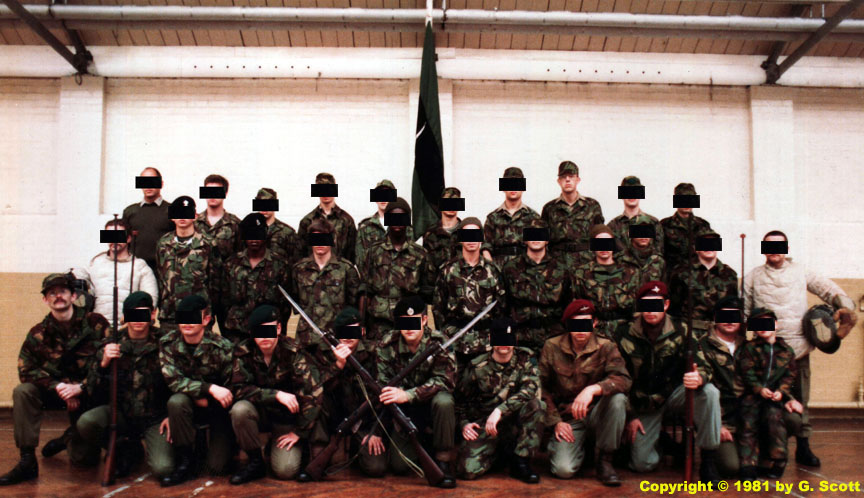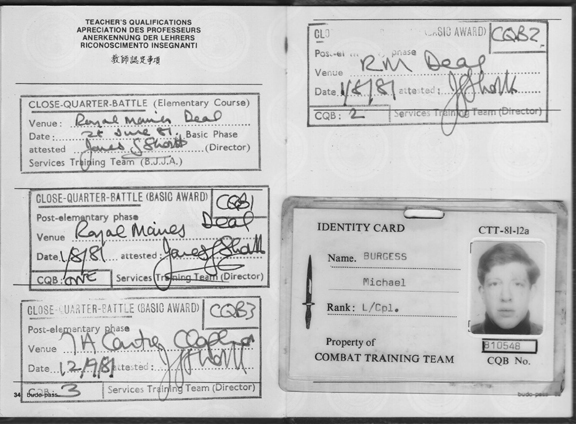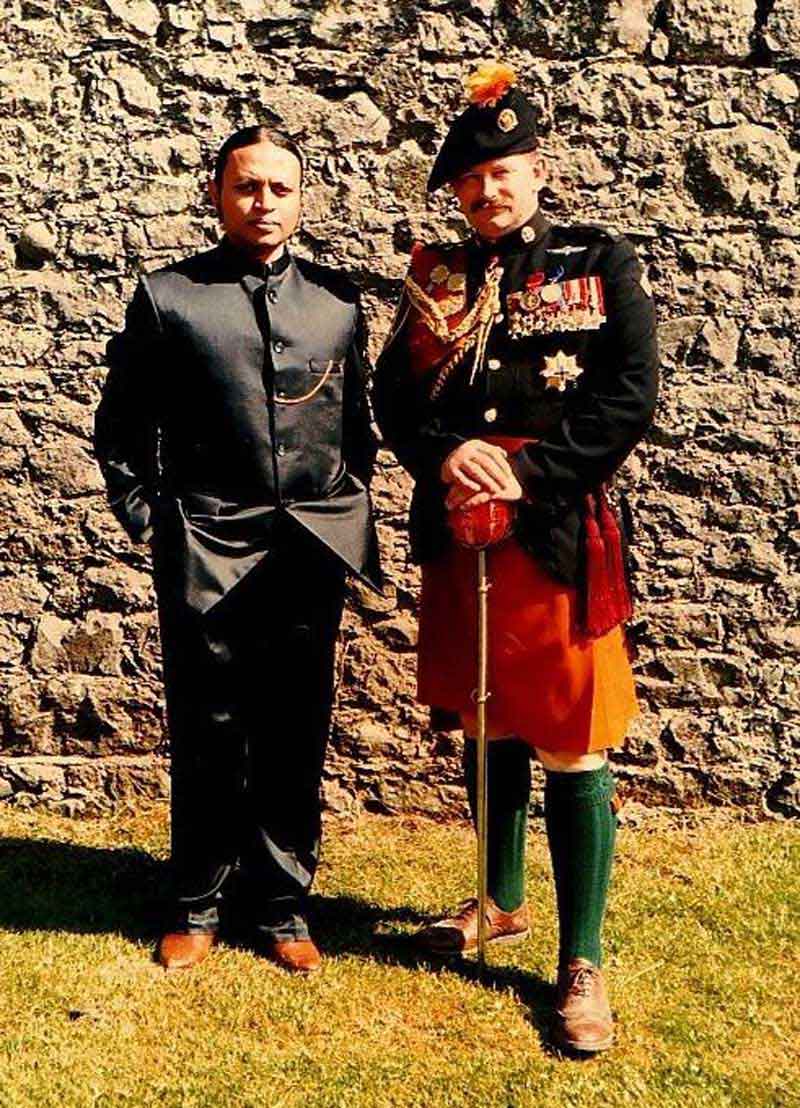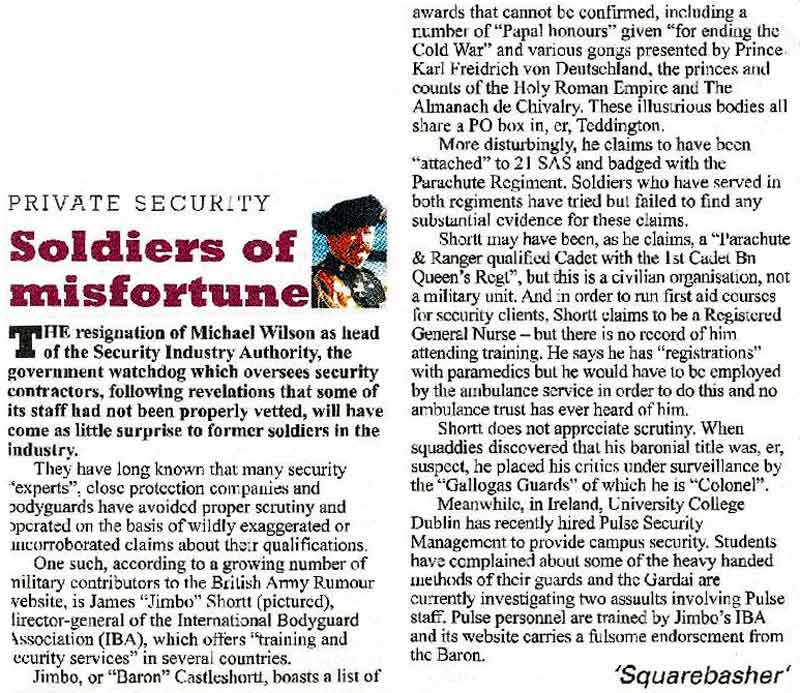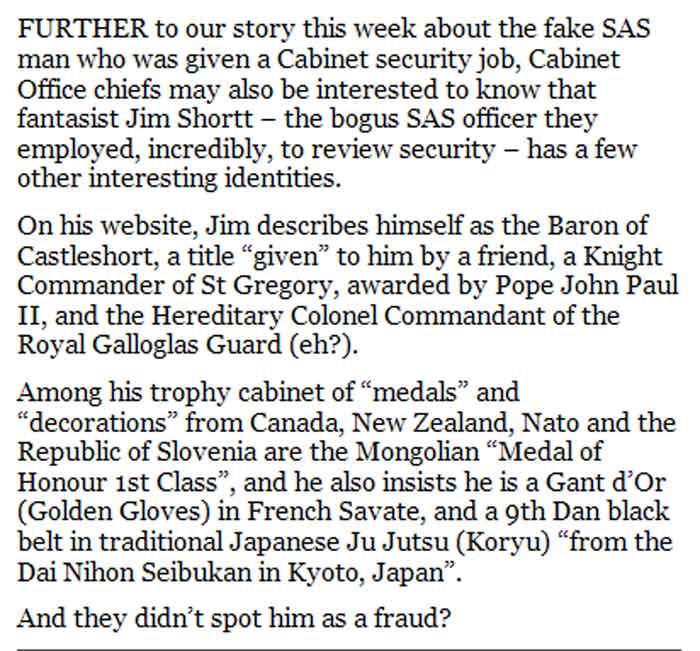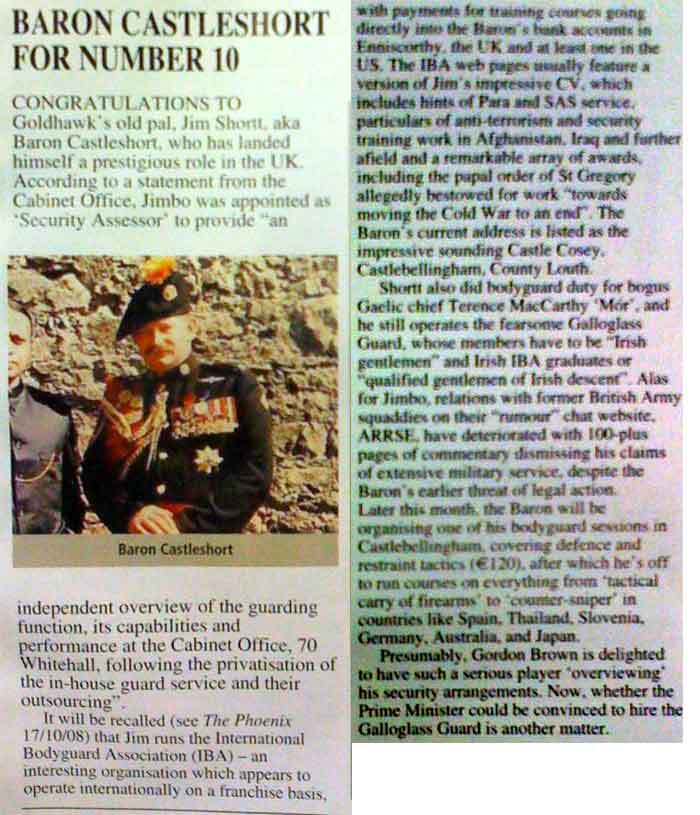Walter Mitty was the iconic anti-hero of James Thurber’s short story “The Secret Life of Walter Mitty” which was first published in The New Yorker on March 18, 1939. He reached an international audience when a Hollywood movie with that title was released in 1947, giving the English-speaking world a simple phrase to describe a person who indulges grandiose fantasies.
In the online forum of the British Army Rumour Service (ARRSE) the abbreviation “Walt” describes anybody who claims military achievements beyond his actual service. A Walt may turn up at veterans parades wearing a uniform to which he is not entitled. He may even be wearing special-forces wings for which he never qualified or a rack of medals he bought on eBay.
Another expression the ARRSE forum uses is “bigging up” to describe the way a Walt may embellish his résumé to impress the gullible. In the United States, extreme walting is called “stolen valor” and it’s a crime for which the penalty may include imprisonment. In the U.K., the Walt merely risks exposure and some ridicule on the Internet or in conventional media.
Ken Dodd once said. “If you tuck your shirt into your pants, you’re a frustrated footballer. And if you tuck your overcoat into your pants, you’re just frustrated.” Who knows what neurosis inspires an otherwise respectable individual to purchase an aristocratic title and appear in public in a ceremonial uniform he has invented for himself?
I spent more than 25 years assuming that certain things were true but my assumptions were cast into doubt when I stumbled upon the Web sites of my former instructor Jim Shortt. In response to numerous postings on ARRSE, I felt compelled to put together the following reminiscences of this interesting individual.
I attended two Close Quarter Battle weekend training sessions at the Royal Marines Depot down in Deal. The location may look impressive on the résumés of Combat Training Team alumni who seek casual employment as bodyguards. But, as far as I know, the Royal Marines Depot in Deal is not where they train commandos. It's where they keep the band. And the CTT was allowed to train in the band's gym, sleep the Saturday night on the gym floor and eat in the cookhouse.
The reason my TA colleague and I had driven, with our sleeping bags and a consignment of martial arts batons, all the way down to Deal for the weekend of June 20-21, 1981, was because we'd been told Jim Shortt was a former sergeant in the elite Special Air Service and, for a small fee, he would transform us into counter-terrorist warriors. The joining instructions had looked interesting. But it was a bit of a shame no rail warrant was available.
Shortt never confirmed whether he was an NCO. I never saw him wear any rank. Maybe it was customary for special forces types to conceal their rank by not wearing stripes. But he always wore a rather nice blue SAS stable belt with his lightweights. And I assumed that nobody would get away with that on MOD property if they were not SAS.
Shortt must have been under some kind of pressure from the authorities because he made a little speech to scotch the rumour that David Stirling was backing the enterprise or had anything whatever to do with it. I hadn't heard that particular rumour. Somebody even had to explain to me that David Sterling was the founder of the SAS.
The official line from Shortt was that he was going to train us all to be instructors in his Close Quarter Battle system, which is more suited for counterinsurgency operations than any of the existing methods used by British forces in, let's say, Ireland.
Because his CQB is based on jiu jitsu it offers a level of force that instantly can be adjusted to the appropriate level; whereas the existing orthodoxy tended to involve shooting people dead or giving them grievous head injuries. It was obvious, therefore, that there were some senior brass whose careers depended on Shortt's CQB course not being adopted.
Shortt's assistant instructor was a Marine corporal named Bernie Finan. It was explained that Finan was a PTI who was in process of being invalided out of his elite Commando unit because of an accumulation of injuries sustained in the streets of Belfast while pioneering the practice of driving an APC over barricades.
Finan liked to tell us stories about practical jokes he’d pulled. He said he would stretch invisible cling film across a toilet under the seat or leave a dollop of crunchy peanut butter on the back of the seat and then unscrew the light bulb so that these effects would be encountered in total darkness by the next person to use the facilities.
He said he devised a way to discourage street urchins from throwing rocks at army patrols in Northern Ireland. Having removed a baton round from its cartridge and inserted a mixture of pearl barley and rock salt held in place with a rubber bath plug, he would fire this at the backsides of the children as they ran away. This, he believed would put the little blighters through the indignity of having to spend the evening on mother’s knee having the stinging pearl barley pellets removed with tweezers.
The most memorable lectures Finan gave us were counter terrorism, sentry neutralisation and hostage extraction. He was a single parent. I don’t know if he was a widower or if his wife had tired of sitting her bare arse on crunchy peanut butter in the dark of the family bathroom. He used to bring his little boy, awfully cute in miniature combats, to the training sessions.
The use of a Royal Marines base on the south coast rather than an army camp at a more central location was, according to Shortt, an indication that the navy was more progressive in these matters than the army. He told us it was rather like the time when the army put an end to bayonet fencing whereas the navy has allowed the sport to continue into the 1950s. Of course it’s quite likely he was running the show in the Marines depot because Finan was able to swing some sort of Sgt. Bilko manoeuvre with his bosses.
Shortt was confident that his CQB would eventually be adopted by the mainstream of the military establishment. He asked us to come forward if we knew of any potential investors. Ultimately, he said, the team would get somebody like HRH The Prince of Wales to be a patron. Did any of us have any contacts who would assist in expediting this?
I was intrigued by the idea of bringing private capital into the venture. So I took advantage of a quiet moment to ask Shortt what kind of return an he might expect. “None,” he replied with a grin. “We just want donations.”
Possibly the best lesson Shortt taught me was no avoid getting into the close quarter fight in the first place. It’s better to lie down 200 yards away and do the job with a rifle. Maybe even smarter to be a few thousand miles away and send in a squadron of bombers.
It doesn’t matter how brilliant a martial arts practitioner you may be. The other fellow can always get lucky. You can slip at a crucial time or be crippled with a sudden cramp. And the other fellow may be a sloppy drunk who happens to deliver the killer blow by accident. That understood, Shortt introduced us to the concept of the three arseholes:
- What to do when somebody grabs you with one hand? You’re an arsehole because if he grabbed you, he might have struck you or stabbed you to death.
- What to do when somebody grabs you with both hands? You’re an arsehole twice.
- What to do when somebody grabs you from behind? You’re an arsehole three times.
He had us practicing certain responses to all these situations with various combinations of throwing, locking, striking and constriction. But this isn’t a sport like judo. You can’t expect the move to work unless you distract your opponent with a little pain before you try putting on the lock or the throw or whatever. This concept was introduced with a Japanese name “metsubishi” or “shadow.” Apparently the literal translation is “to crush the eye.”
Bayonet fencing was a key element in the CQB philosophy. Shortt said he wanted to bring it back as a competitive sport. He reminded us that our basic training probably skimped on it. And I did recall one instructor at Pirbright telling us, “You could mount a bayonet on a submachine gun. But it’s a short weapon and, if the enemy is as close as that, you might as well just chuck it and run.”
Shortt was critical of this approach. He said one lesson the U.S. forces should have learned in Vietnam was that you need bayonet skills when your position is being overrun and you’ve run out of ammunition.
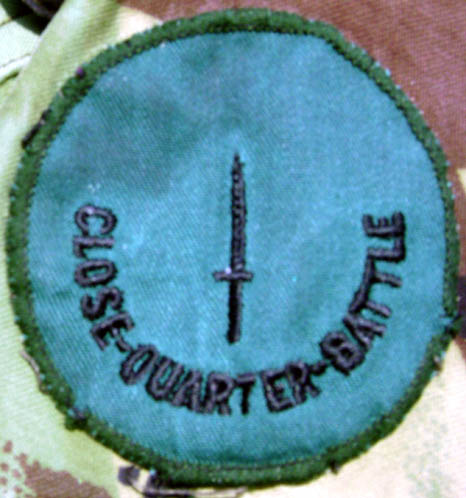
Shortt issued us with a round green cloth badge we were supposed to sew onto the sleeves of our combats. He said it would only be a matter of time before the badge was authorised. But, until then, we'd have to make sure we had a spare combat jacket just to wear at CQB training. Fair enough. He also sold us some little Staybrite dagger lapel badges that we were supposed to wear as a cap badge. They were designed for lapel of a business suit, where they gave a quiet impression that the wearer was a hard-as-nails special operative. But, on a beret or a combat cap, they would tend to rotate through the day and there was no way of knowing if your little silver dagger was pointing up, down or sideways.
I never saw Shortt wear the famous sand-colored beret. His CTT uniform head dress was a blue beret with the little silver dagger cap badge. He undid the adjuster at the back of his beret and let the ends dangle behind. I think he said this was a popular style in the French special forces. Nobody seemed terribly impressed with the dangly bootlace look and it never caught on.
Short always brought several toolbags full of weapons to the training sessions and would display them all on a table where we could while away any spare time playing with the nunchakus, handcuffs, telescopic batons etc. On the same table would be a couple of photo albums so we could see snaps of an earlier class he had set up to teach hostage extraction to the USAAF personnel stationed at some base in England. At least one photo showed Shortt posing with the cast of a popular TV show called The Professionals. Shortt claimed he had been a consultant to the series.
He ran the CQB class very much in the style of a conventional army PT instructor. He'd explain a concept, demonstrate it on some poor sap, and then have us work in twos around the gym practicing it while he strolled around warning us that, if we hurt our partner too badly, it would come back on us when it was their turn. While we did this, we had to keep a weather eye open for Finan’s little boy who, without any warning, would charge across the room brandishing a bayonet or some other weapon from the toy table.
Shortt encouraged all of us to attend his jiu jutsu dojo in Purley as often as possible. Like a fool, I cycled there for an evening’s training and didn’t get home to Notting Hill Gate until long after midnight. My TA colleague had more sense. He lived in Streatham and owned a car.
The dojo crowd was mostly pretty boys in black gis showing off their graceful breakfalls. There were a few TA soldiers, one or two females, and a guy who hung around near the door lifting free weights all evening. We were told everybody in traditional jiu jutsu has a white belt because a fighter’s level of skill or lack of it should be patently obvious. The training took a similar form to the CQB class. Every once in a while, Shortt would effortlessly put the Vulcan death grip on me. And then I was expected to remember how it went so I could practice doing it to whoever I was paired up with.
It’s supposed to be like learning a language. If you practice it enough, you should have an answer to anything. There’s no doubt Shortt's moves were fluent and expressive. The story was that he had been taught during his childhood by his father. And then the monks had given him special permission to practice during his time at the monastery. And here he was, a former SAS soldier, raising a young family in Purley on his income as a freelance medical journalist while, in his spare time, crusading to reform the misguided CQB methods of the British armed forces.
In the back of the church hall was some kind of a sacristy where Shortt kept an interesting little shrine. There was an old photo of a smooth looking Ian Fleming type in a chalk-stripe suit. Maybe that was his old dad Peter Henry Shortt. And there was another monochrome photo that looked much older. It showed a fierce looking Asian man striding towards the camera with a Japanese sword in a room that, judging from the dramatic lighting, may have been an ancient temple or the set of a Fu Manchu movie. I assumed these revered photos were Shortt’s teacher and his teacher’s teacher. I imagined the sensei meditated there in a moment’s solitude before every class.
The next CQB course was held in Deal the weekend of Aug. 1-2, 1981. By now, there was a touch of paranoia in Shortt’s pep talk. The higher echelons of the British army were getting reports about the CQB courses. Shortt said there were definitely spies among us.
But who was spying on behalf of the stick-in-the-mud army establishment? We were such a mixed bag. Probably everybody was reporting somewhere. The adjutant of my own unit had asked me some odd questions but didn’t seem terribly impressed with my answers.
One guy at Deal told me he was a regular in the Royal Engineers and he had heard such good things about the CQB course he'd come over from Germany on leave, at his own expense.
There were some, wearing red berets, who looked a bit old to be jumping out of a Herky bird. I could have sworn I recognized one of them as an actor who used to appear in non-speaking roles in TV shows such as The Sweeney. He could be with 10 Para out of White City.
One or two confided they were civilian policemen looking to improve their pistol skills. There was a pilot officer from the RAF who looked like a very young Edward Woodward and chatted to me all day in fluent officers-mess banter.
About half a dozen Royal Marines were there. They were all young and fit with the right haircuts and perfectly shaped green berets. There was no mistaking they were the real thing. It was clear they idolized Finan and it’s more than likely he personally had brought them down from Poole. We didn’t know the Falklands War would begin the following April. And it’s possible those fine young men found themselves yomping to Stanley. Who knows if they all came back?
It was hinted that some of those who wore combat caps or caps comforter instead of berets were actual members of the SAS or the SBS. Shortt liked to refer to those organisations as the Southall Asian Society or the South Bank Show. On the one hand, it was understood that the special forces contingent wasn’t allowed to divulge their affiliation to anybody. On the other hand, as Shortt told us, if the didn’t tell anybody, none of them would have girlfriends.
The only one who openly admitted to being SAS was an enormous black guy who also happened to divulge that his father was a Colonel in the Navy SEALs, over in the USA. I’m six foot four. And he must have been six inches taller than me with arms bigger than my legs. He told me he spent eight hours every day training to kill. To me, this was the opposite of inspirational. One day I'd be sure to come up against somebody who has nothing better to do than train for eight hours a day and I'd be dead meat.
One of his Purley mob told me off because he’d spotted me riding my bike along Kensington Gore while wearing my CQB combat smock. The CTT didn’t have much. But it wasn’t going to stand for any mixed dress.
I’m pretty sure this was the weekend the group photo was taken. I’ve put the black oblongs over the faces of everybody except Shortt and myself because, if there’s any possibility somebody in the group is active in some kind of sneaky-beaky work, there’s really no need to expose them on the Internet like this.
Note the big scary SAS man in the center row, fourth from the left. And of course there’s Finan on the far right with his little boy on his knee. On each side of the group stands a man dressed in the white padded suit we wore for bayonet fencing. Each of them is holding a fencing mask in one hand. In the other he is holding the specially modified DP Short Magazine Lee Enfield with the sprung plunger with a knob on the end that looks a bit like a doorstopper. When it's thrust against an opponent, the plunger will compress harmlessly into the barrel like one of those plastic toy daggers you may have had as a child.
I got the impression that Shortt’s idea of a good Saturday night is to go to the pub with his best students and see if he can start a fight. And I don’t know if the CTT outwore its welcome in Deal after that weekend but the next session was held on Saturday Sept. 12, 1981 in a TA drill hall near Clapham Junction station.
We followed the usual agenda. There were various weapons distributed around the room for us to practice against each other in twos. There was equipment for two forms of fencing. I’d never tried using foils before and two of us suited up and hacked wildly at each other. I got a chance to lunge at my partner’s chest padding and my foil snapped in half. So that was the end of that.
The grand finale of the day had us divide into two groups and line up to match up against each other with the specially sprung bayonet devices. As my line got shorter, I counted the line on the other side of the room and was horrified to realize that my opponent would be that great big black SAS man who spends eight hours a day training to kill people with his bare hands.
When the time came to suit up, he had some trouble getting the protective mask on over his ‘fro. It didn’t matter, he said. He chuckled in the certainty that no harm would come to him.
I was beyond terrified. We faced each other in the center of the room, our weapons crossed in the manner required as we waited for the signal to start fighting. The Lee Enfield is heavy and, it turns out, quite difficult to swing accurately in a parry or a thrust.
Essentially, my approach to bayonet fencing can be described as flinching and flailing. I think my eyes were actually closed when the tip of my weapon slipped underneath my opponent’s protective mask and cut a deep hole in his face. The doorstopper gizmo wasn't as soft as it had looked. And the sideways moment of the weapon must have caused too much friction in the rifle barrel for the sprung plunger to slide inside. His white padding was turning horribly red as it very effectively absorbed the blood that seemed to gush onto it. Game over.
My TA colleague drove the wounded soldier to a local hospital for some stitches. There were no hard feelings. He knew I was an idiot. Afterwards he came back to the drill hall and shook my hand. He told me he’d had to protect his identity at the hospital by giving my name rank and number. I think he was quite pleased there might be a scar. And, in my own case, I have to admit the lessons of CQB changed my whole life.

